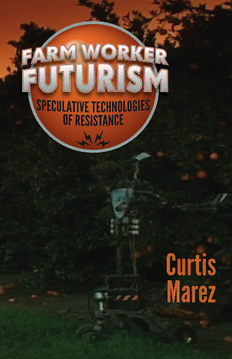
Farm Worker Futurism: Speculative Technologies of Resistance PDF
Preview Farm Worker Futurism: Speculative Technologies of Resistance
Farm Worker Futurism DIFFERENCE INCORPORATED Roderick A. Ferguson and Grace Kyungwon Hong, Series Editors Farm Worker Futurism Speculative Technologies of Resistance Curtis Marez DIFFERENCE INCORPORATED University of Minnesota Press Minneapolis • London An earlier version of chapter 2 was published digitally as “Cesar Chavez’s Video Collection,” American Literature 85, no. 4 (2013); http://americanliterature .dukejournals.org/content/85/4/811. Portions of chapter 3 were published as “Cesar Chavez, the United Farm Workers, and the History of Star Wars,” in Race after the Internet, Lisa Nakamura and Peter Chow White, eds. (Abingdon, Oxon: Routledge, 2011), 85–106; copyright 2011 by Taylor and Francis; reprinted by permission of Taylor and Francis Group, LLC, a division of Informa plc. Copyright 2016 by the Regents of the University of Minnesota All rights reserved. No part of this publication may be reproduced, stored in a retrieval system, or transmitted, in any form or by any means, electronic, mechanical, photocopying, recording, or otherwise, without the prior written permission of the publisher. Published by the University of Minnesota Press 111 Third Avenue South, Suite 290 Minneapolis, MN 55401- 2520 http://www.upress.umn.edu Printed in the United States of America on acid- free paper The University of Minnesota is an equal- opportunity educator and employer. 22 21 20 19 18 17 16 10 9 8 7 6 5 4 3 2 1 Library of Congress Cataloging-in-Publication Data Names: Marez, Curtis, author. Title: Farm worker futurism : speculative technologies of resistance / Curtis Marez. Description: Minneapolis : University of Minnesota Press, 2016. | Series: Difference incorporated | Includes bibliographical references and index. Identifiers: LCCN 2015039885| ISBN 978-0-8166-7231-8 (hc) | ISBN 978-0-8166-9745-8 (pb) Subjects: LCSH: Agricultural laborers—Effect of automation on—California—History— 20th century. | Agricultural industries—California—Automation. | Agricultural laborers— Political activity—California—History—20th century. | Agricultural laborers—Labor unions—California—History—20th century. | Labor movement in motion pictures. Classification: LCC HD1527.C2 M36 2016 | DDC 331.7/63097301—dc23 LC record available at http://lccn.loc.gov/2015039885 To Shelley This page intentionally left blank Contents Preface and Acknowledgments ix Introduction: Farm Workers in the Machine 1 1 “To the Disinherited Belongs the Future”: Farm Worker Futurism in the 1940s 43 2 From Third Cinema to National Video: Visual Technologies and UFW World Building 79 3 Farm Worker Futurisms in Speculative Culture: George Lucas and Ester Hernandez 119 Afterword: Farm Worker Futurism Now 155 Notes 183 Index 207 This page intentionally left blank Preface and Acknowledgments This book is an interdisciplinary study of the material and symbolic sig- nificance of technology in conflicts between agribusiness corporations and workers of color in California from the 1940s to the 1990s and beyond. An important practical and symbolic means of exploiting and disciplin- ing labor, agribusiness technology also became the medium and object of struggle over the future of California agriculture and the larger cultural and political contexts supporting it. Farm workers have opposed mecha- nization in the fields, industrial work camps, and, perhaps most famously, pesticides. They have also responded to capitalist efforts to dominate the visual field by turning a critical gaze on agribusiness in numerous graph- ics, photos, films, and videos, decoupling technology from an exclusive connection to patriarchal white capitalism. Farm worker unions did not simply change what audiences saw but instead attempted to alter how they saw agribusiness, inverting the hierarchical relations of looking that structured the agribusiness- dominated mediascape, and promoting new kinds of activist spectatorship among farm workers and their support- ers. Finally, farm workers have appropriated visual technologies to imag- ine better worlds and to project different, more egalitarian social orders. From this perspective, farm workers’ visual technologies— including mov- ing picture cameras, video cameras and players, and computer screens— constitute tools for speculative world- building. One reason that scholars have not appreciated the political signifi- cance of what I call farm worker futurism is because they have not always attempted to understand and model farm worker visions of the world. Recalling the historical materialist method of research and analysis Walter Benjamin developed for his “Arcades Project,” Farm Worker Futurism employs a method of reading and interpretation that juxtaposes often ix
